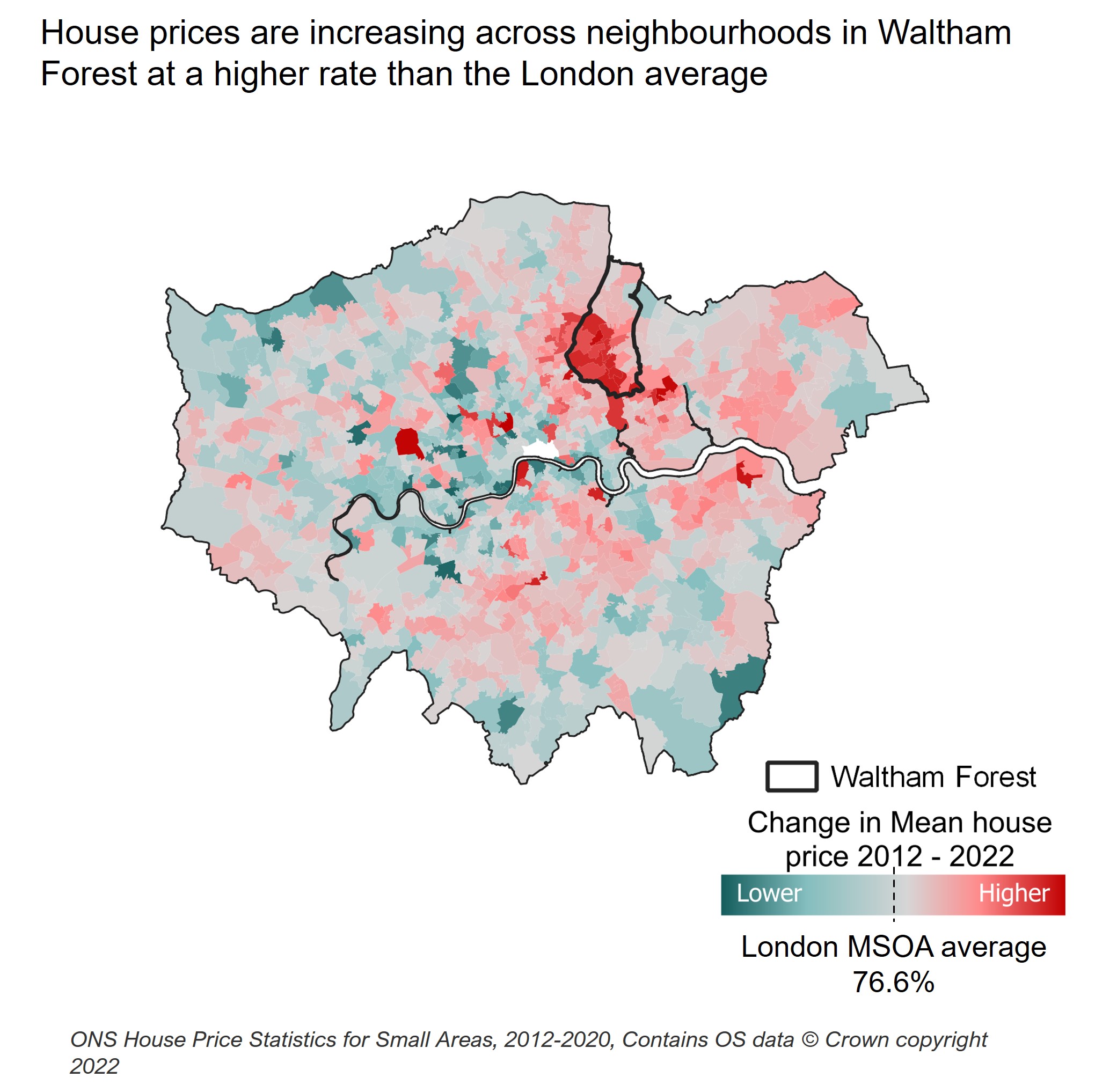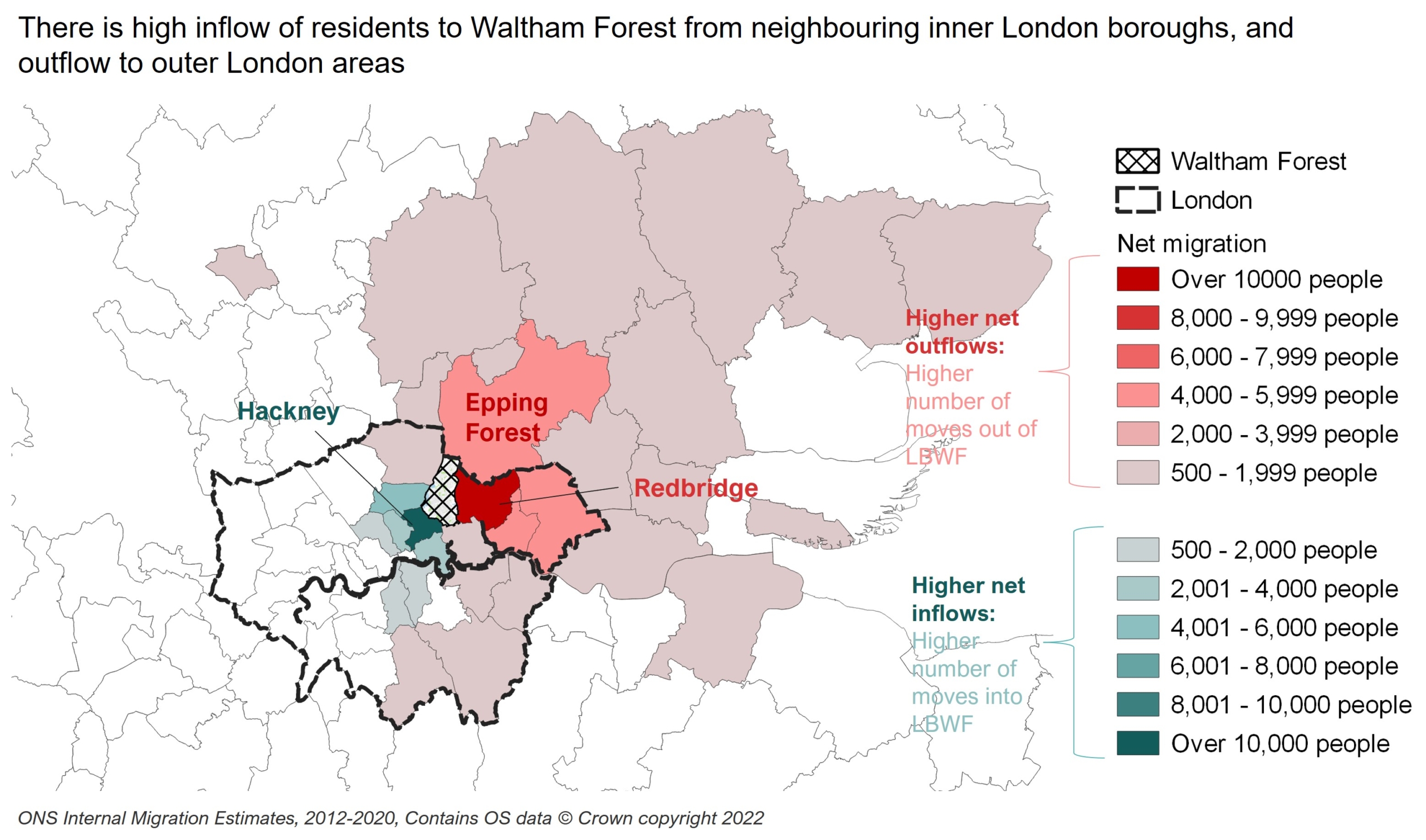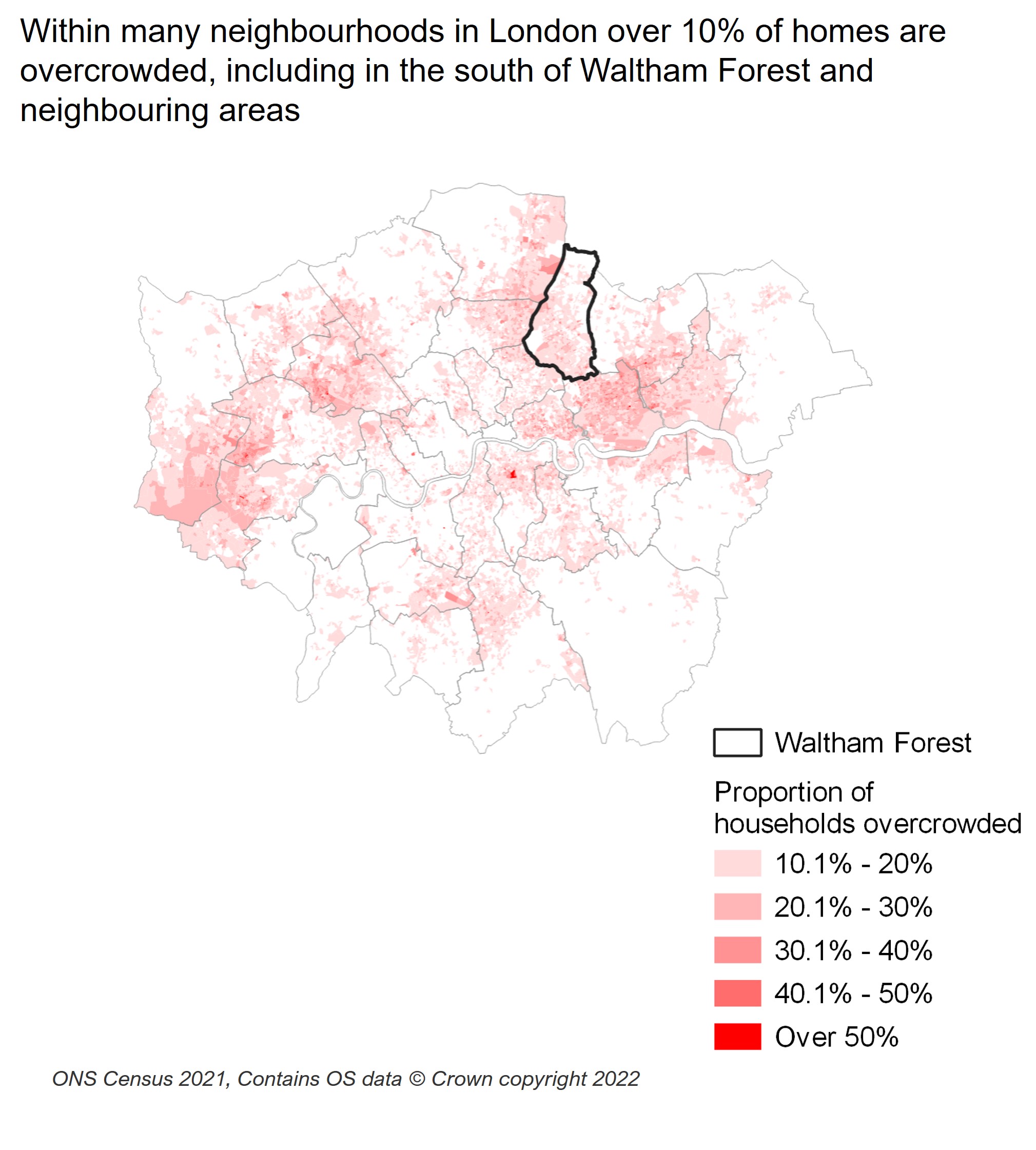The housing crisis in east London: evidence and recommendations for change
The London Borough of Waltham Forest established the Waltham Forest Housing Commission earlier this year. It brought together independent experts to provide recommendations for how the Council can accelerate the delivery of genuinely affordable homes. PRD provided the Commission with evidence to support its recommendations.
London’s housing market is broken. A decade of spiralling rents and house prices has been pushed to new extremes by a toxic combination of post-pandemic demand, supply shortages, and rising interest rates. The response has remained firmly on the supply side, focussing on the need to build more housing, which, whilst critical, creates a narrow political imperative.
Housing is personal. By combining better data with lived experience, decision makers can re-humanise housing to deliver a more effective local response. This must be based on the importance of a secure home to prosperity, health and wellbeing and a life well lived, rather than a source of wealth.
What the data told us: a deepening challenge exacerbated by the cost of living crisis
To provide well-rounded recommendations, The Waltham Forest Housing Commission required insight into the depth and effects of the housing crisis. This needed to go beyond statistics on delivery to understand the lived experience of housing in one of the fastest (if not the fastest) changing areas in the country.
Our analysis showed that as London’s housing crisis has deepened, the ripple effects are reaching farther into Outer London. Over the last ten years, Waltham Forest has absorbed high net migration from more expensive Inner London neighbours such as Hackney, whilst many people have left for cheaper boroughs such as Redbridge and Barking and Dagenham.
Major demographic changes in Waltham Forest are indicative of this domino effect. For example, the well-publicised flight of young families from Central London has in part been absorbed by the borough. Waltham Forest has seen the number of families with dependent children increase by 6% over the last decade, whereas the number fell by 2% in Camden.
The occupational profile of residents has also changed, with the borough experiencing the second-highest percentage increase of residents working in higher managerial, administrative and professional occupations in London since 2011.
Shifting demand has been a key driver of rising housing costs, especially for family-sized homes. Since 2012, house prices in Waltham Forest have increased at the fastest rate in England – with largest increases found in Leyton and Walthamstow where the borough’s well-connected terraced housing stock is located.

At a time when inflation is impacting upon all other essentials as evidenced through PRD’s cost of living calculator, high and rising housing costs are exacerbating the impact on households. The housing crisis in Waltham Forest is now affecting most households in some form, with the average one-bedroom property costing 40% of median gross pay, driving more people into hardship.
Local authorities are having to make impossible choices to cope with the growing crisis. The proportion of residents in Waltham Forest who have been assessed as homeless has grown by 55% since 2019, whilst London boroughs’ core funding from government fell by 63% between 2010 and 2019.
The human impact: a lack of choice across the system
Whilst this data underpins a clear moral imperative to act, it provides limited insight into the secondary impacts of the crisis. This risks a one-dimensional policy response which fails to capture the importance of a secure home to resident prosperity and wellbeing.
To address this, the Waltham Forest Housing Commission prioritised conversations with residents to understand their experiences of living in the borough. These discussions made it clear that the housing crisis is now leading to an erosion of choice for most residents, regardless of tenure.
We heard from owners who were unable to move up the ‘housing ladder’ due to increased costs; social renters who were not able to access homes that meet their changing needs; and private renters who found it hard to find a secure home due to increased competition.
“We had three months to find a new place to live; there was nothing. We’d call agents and it would be gone before it was listed. Or they asked to come to viewings at 10 minutes notice when we’re both at work… You have to make a decision knowing almost nothing; you don’t get to meet the landlord before signing a lease.”
General focus group participant – private renter
Residents told us that family homes were hard to find due to a combination of high demand, conversion of housing into flats and a lack of options for those wanting to downsize.
This is making it difficult for people to plan for their futures and control fundamental aspects of their lives. Residents told us how their adult children were unable to move out of their family home (there has been a 22.1% increase in adult children living at home in Waltham Forest since 2011 ) or that they were prevented from starting their own families due to not having sufficient bedrooms.
“We’re on top of each other. It’s affecting the children’s sleeping patterns, which is affecting their schooling.”
General focus group participant – living in social housing
A lack of space is evident in Waltham Forest which has the fourth highest rate of overcrowding in Outer London, with 18% of homes now classed as overcrowded.
Several people spoke about their experience of overcrowding which tended to be because of families outgrowing long-term homes.
Why do these issues matter? The secondary effects of poor housing are stark. A lack of housing options is leading to stress and anxiety, as well as physical health problems. Some residents told us they were stuck living in unsafe homes, worried about raising concerns with landlords for fear of being asked to leave, and being unable to find housing elsewhere if they need to move away.
The response: housing as the foundation for a good life
These wider impacts require a cross-cutting response that reframes the housing crisis as something that is undermining people’s quality of life.
Talking about housing as an enabler of health and wellbeing is a key recommendation from a recent JRF report ‘How to Talk About Homes’. By getting beyond the headline data and understanding the impacts on residents’ everyday lives, places such as Waltham Forest can begin to tell a new story about housing, one that is centred on why good homes matter.
Waltham Forest Council has started to implement this approach, undertaking groundbreaking research with the Marmot Institute which proposed interventions to tackle the links between housing and health inequalities. This includes specific recommendations to create new roles in both the council and NHS for senior staff to work directly with housing providers to reduce the risk of inadequate housing causing poor physical and mental health.
There is a strong case for local authorities’ remits to be extended in this way to tackle the key social determinants of health. There are pockets of exciting work being piloted in this space such as the Shaping Places for Healthier Lives Programme. This joint grant programme between The Health Foundation and Local Government Association seeks to support local authorities to facilitate and enable local partnerships for system change to tackle food insecurity, mental health, and fear of violence and crime.
Contrary to the wider narrative, local government has proven time and again that it can deliver. Over the last ten years, Waltham Forest has delivered the largest proportion of affordable homes of any London borough. With the right powers and resources, authorities such as Waltham Forest can build on their delivery track record to lead a more systematic public sector approach to the housing crisis – responding to both its causes and effects.
– By Will Temple and Rose Jump. Please contact us if you would like to learn more about our work on housing and how it might apply to your area.

